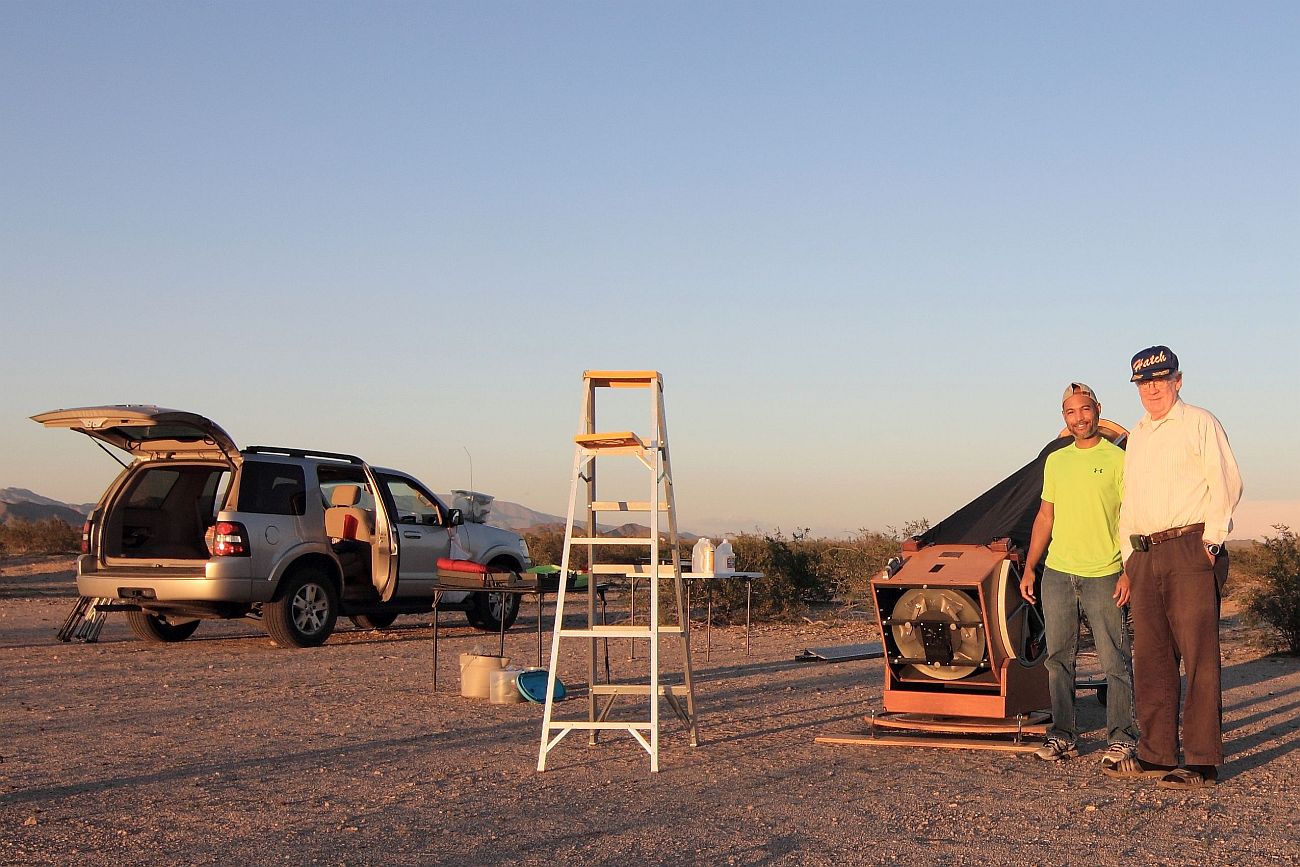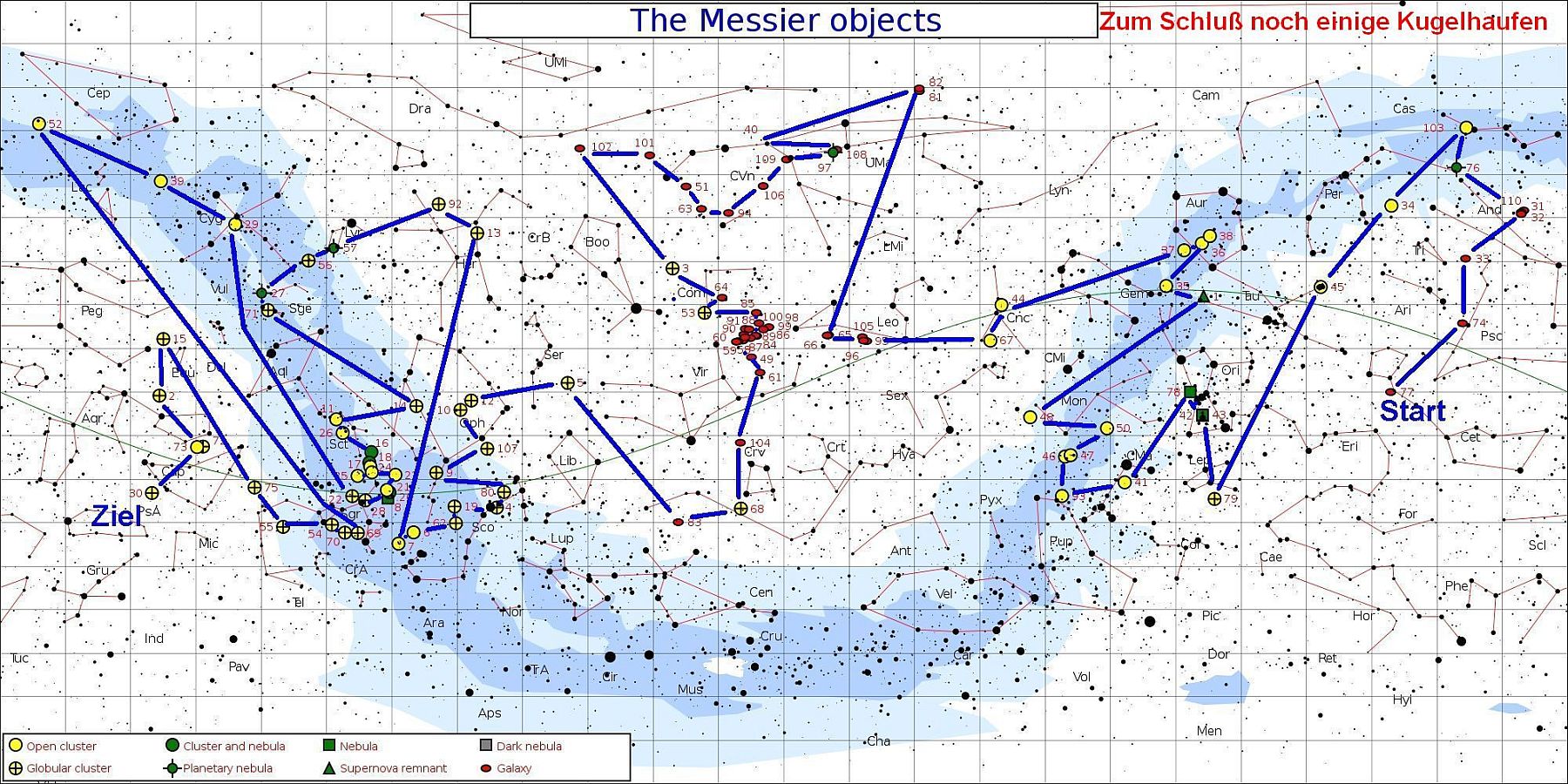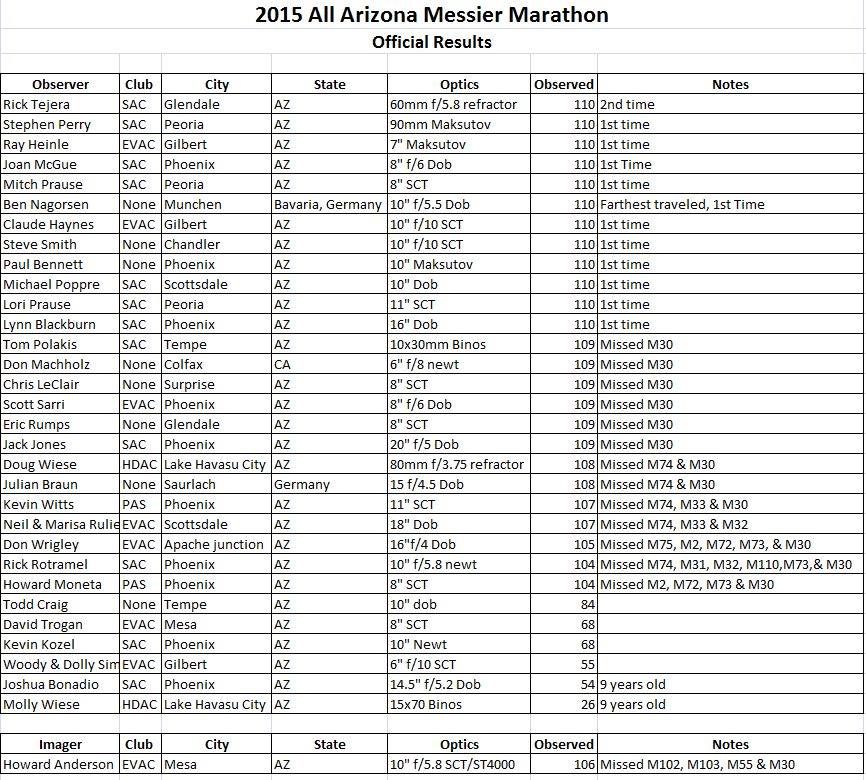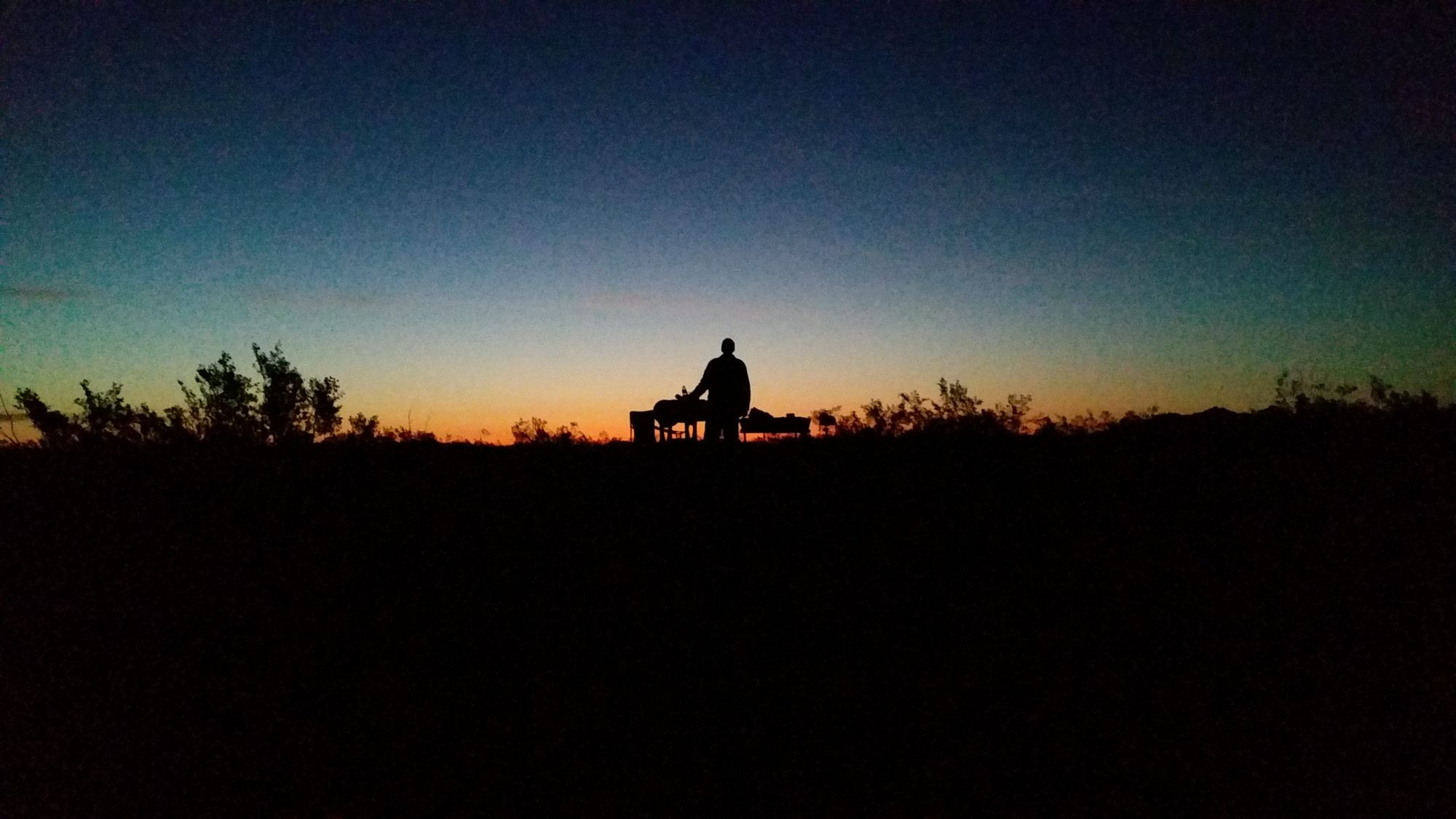Julian starts his drone

Our neighbors Lamar (with 20-inch) and Paul

Julian starts his drone
|
Our neighbors Lamar (with 20-inch) and Paul
|
With Tom's 10" f/5.5 and Earth's shadow
|
Friday evening: Sunset
|
I tried some initial Messier objects for testing, and then went through the whole lot of the winter Messiers up to M67 and M44 in one go. And not to forget
southern objects like the dense open cluster NGC 2477. In between I also visited our southern neighbors. Lamar observed several emission nebulae with his
20-inch, among them the Rosette Nebula and "Thor's Helmet" NGC 2359 - what Friedhelm and I call the "Snail with shell". On this occasion I showed him
another Wolf Rayet bubble, Sharpless 308 in Canis Major, which is located considerably higher here than at home, showing differently bright parts of a ring
with the OIII-filter. And Paul, a geologist with a 25-inch, prepared a nice buffet: The "Medusa Nebula" Abell 21 and the galaxies M66 and M95 - with some
interesting details.
But the night became increasingly more wet, while local folks assured me that this was very rare here. That wouldn't be good at all for the coming Marathon
night of course, and would set a big question mark concerning its success. Lamar promised me handwarmers which could be fixed to the secondary mirror -
just in case. So with deteriorating conditions I went for a nap, but was up again around 4:00 AM. The conditions were a bit better again now, and I followed the
further events in the eastern sky with interest, using my 8x56 binoculars. It was soon clear that southern objects like the globulars M69, M70, M54, M55 and M75
were far easier to get here than at home; what had been really difficult at my home Marathon at Geigersau in 2012, or what I didn't get at all (M55, M75) was quite
easy here - due to the difference in declination of about 14,5°. Only M72, M73 and also M2 were comparatively more difficult because of their rise within the light
dome of Phoenix, while it seemed that M30 would rise sufficiently away from it to the right. But I didn't wait for M30; the sky was still wet, and quite brightened
near the horizon, there would have been no chance to glimpse it anyway.
Tom prepares the 15-inch
|
f.l. Ben, Julian, Jack Jones, Tom Mozdzen, Jennifer, Tom and Ken Reeves
|
|
|
|
|
At 5:00 PM organizer Rick invited to a meeting
|
Raffle: Jennifer, Tom and Rick, and two young judges
|
The initial cirrus in the NW was ... |
... increasingly dissolving: Canopus near the horizon
|
Copyright image by permission of Jim Cornmell: Jim's Cosmos

Around the time of the image above (with Canopus) the Messier Marathon started for me: I did all the observing with Tom's 20 mm Explore Scientific
eyepiece, with the huge field of 100 degrees. That corresponded to a magnification of 69x in the 10-inch f/5.5 Dobson, and to a real field of easily more
than one degree in the sky. I intended to do the Marathon without consulting maps, only out of memory, and that eventually worked out; I had positioned
the two Uranometria star atlases nearby, just in case the sky would deteriorate, and then I might no longer find the star hopping paths - they are quite subtle
e.g. in the Virgo cluster, and easily no longer seen so well. That was fortunately not the case, and the amount of moisture remained limited compared to the
previous night - eyepieces and secondary mirror remained clear all along.
The first objects are those who will soon set in the West, and therefore have to be observed in time. On the other hand one has to wait till the sky is dark
enough: "Already dark enough, but the object not yet too low in the horizontal haze". The high surface brightness galaxy M77 met these conditions already
about 7:40 PM, and so it was the first Messier object of the night. A bit later Tom and I stood near Julian and congratulated him for his M77 observation.
The position of M74
Source: Cartes du Ciel |
M74 is considerably more difficult: Meanwhile I'm very familiar with the position |
Afterwards I went through the winter Messier's - including M52 in Cassiopeia - up to M67 and M44 in one go again. The combination of telrad,
8x50-finder and the 20mm wide field was very convenient for star hopping. There was no time pressure at all for the next hours, and some folks
took a nap for some hours in between.
Ben before the Puppis Milky Way |
Tom as a guest at his 10-inch
|
Julian during the Marathon
|
Paul and Jennifer, at left the 25-inch
|
The Marathon went on leisurely. I had gone through the Virgo Cluster in one go, all with the 20 mm eyepiece, and then it was again time for a
snack on my neighbors buffet again: Lamar was observing the Abell 1367 galaxy cluster in his 20-inch, and showed a great "Whale" NGC 4631.
And Paul observed the interacting NGC 4038/39 galaxies and a very fine Whirlpool M51. Paul was amused about the many object designations
he found in his new Interstellarum "Deep Sky Atlas". Included is the asterism of "Polakis 1" in the star cloud M24, an arrow-like pattern pointing
to M17.
Meanwhile the giant globular cluster Omega Centauri had reached its highest position in the meridian, and was quite impressive in the 15-inch.
That would be interesting for Julian as well - when would we see Omega Centauri the next time ? - but he was apparently taking a nap right now.
Jennifer strongly suggested to wake him, and before I could take action in that respect, Julian came out of the van again, and could marvel at this
southern showpiece.
Jennifer joined me when I was hiking down the summer Milky Way along the Marathon path, and picking up M11, M26, M16, M17 and M18. And
when it was M24's turn, she showed me the family-owned star pattern Polakis 1. The southern objects like M7, M69, M70, M54, M55 or M75 were
all much easier to get here than at home in southern Bavaria.
Observing near M22, at left the Phoenix light dome
|
Don Machholz (left) comes for a visit
|
Don Machholz, the famous discoverer of already 11 comets, was also taking part in the event. He had heard that I do the Marathon out of
memory; I read that he had done so already on many occasions, and this was his 51th Messier Marathon. And so he came along to see the
guest from Europe, and I was appointed the "Machholz of Germany" - really a very nice appreciation, but I'd say it's a bit much too much
of an honour ;-)
So we eventually reached the final phase, and it was not really difficult apart from the last object. One could leisurely wait until first M15,
and then M2, M72 and M73 clawed their way through the light dome of Phoenix. And then 109 objects were done, and only M30 missing.
The position of M30
Source: Cartes du Ciel |
M30 was also theoretically the most difficult object of the evening. Although both brighter (mag 7.3) I've seen all 110 Messier objects ! |
We estimated that the time of the successful observations had been around 5:33 AM; Rick estimated that there had been
a window of perhaps five minutes when it was possible to glimpse M30. Tom had just found 109 Messier objects with his
10x30 (!) binoculars, all but M30 - an extreme performance !
And Julian had managed to get all "normal" 108 objects, all but M74 and M30 - a great performance ! And contrary
to me he really had to work hard on the objects, and usually had to consult the map. He had quite intensively prepared
himself in the last week, also concerning the sequence of the objects. He had my Geigersau list and Rick's current list
at hand, and the latter of course better fits the more southern position here; there a real differences concerning
the best sequence. All in all 12 participants have seen all 110 objects, Rick Tejera has posted the result & infos
And here is as well the official result:

